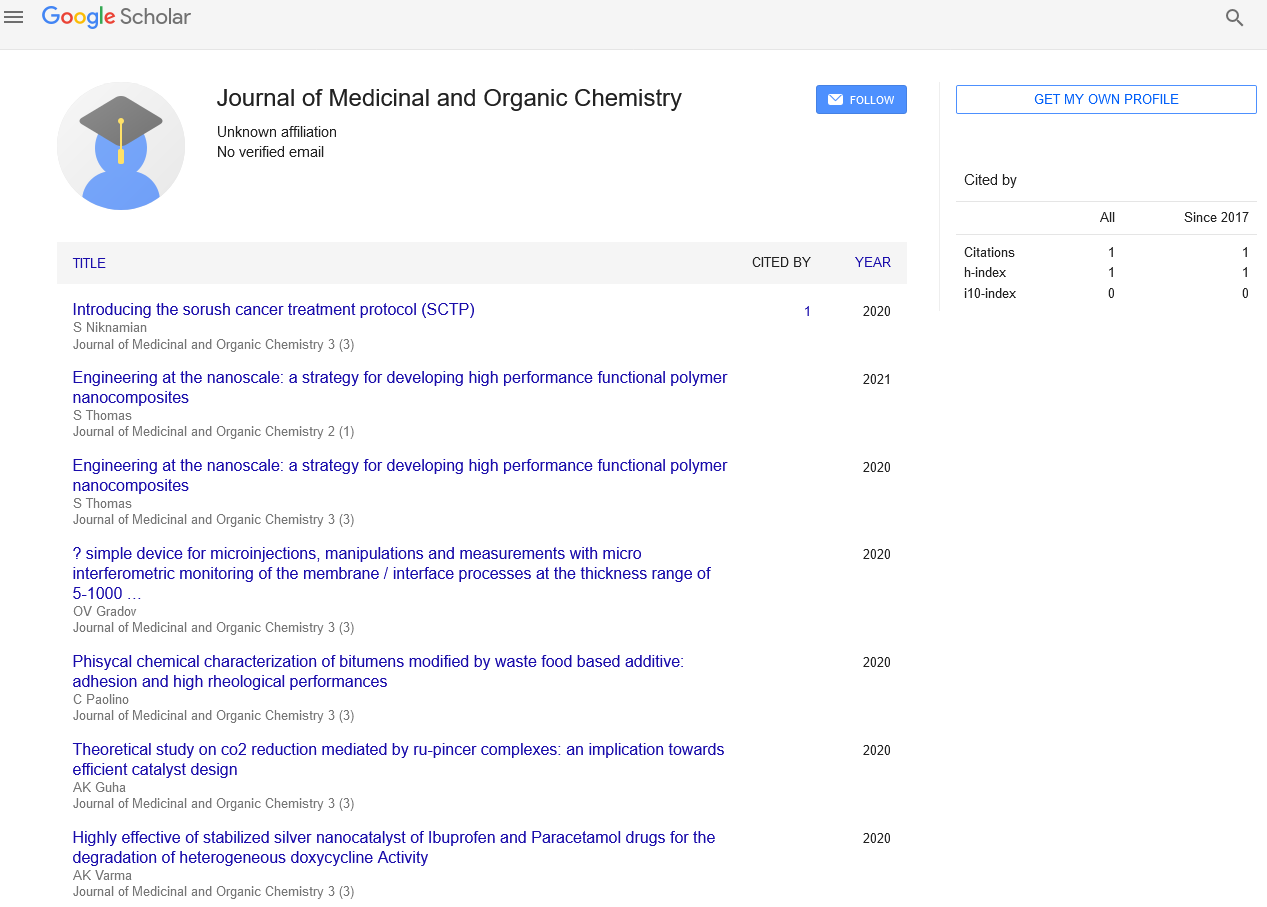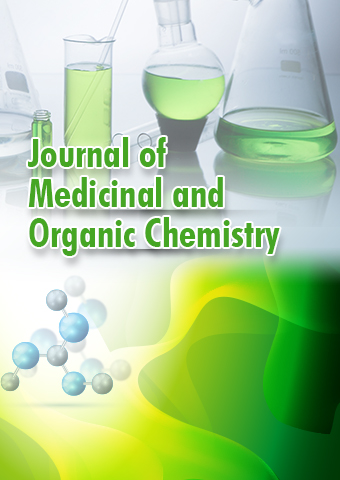Commentary - Journal of Medicinal and Organic Chemistry (2025) Volume 8, Issue 1
Bridging Worlds: Exploring the Synergy of Medicinal and Organic Chemistry
Koustav Sarkar*
Department of Medicinal Chemistry, Jamia Millia Islamia, New Delhi, India
- *Corresponding Author:
- Koustav Sarkar
Department of Medicinal Chemistry, Jamia Millia Islamia, New Delhi, India
E-mail: koustavsarkar@1420gmail.com
Received: 29-Jan-2024, Manuscript No. JMOC-24-126263; Editor assigned: 31-Jan-2024, PreQC No. JMOC-24-126263 (PQ); Reviewed: 14-Feb-2024, QC No. JMOC-24-126263; Revised: 05- Feb-2025, Manuscript No. JMOC-24-126263 (R); Published: 12-Feb-2025, DOI: 10.37532/ jmoc.2025.8(1).279-281
Introduction
About to study
In the vast landscape of chemistry, two disciplines stand out for their profound impact on human health and scientific innovation: Medicinal chemistry and organic chemistry. While each field has its distinct focus and methodologies, the convergence of medicinal and organic chemistry has led to groundbreaking discoveries, transformative therapies, and novel approaches to drug design and development [1-5]. In this comprehensive exploration, we delve into the symbiotic relationship between medicinal and organic chemistry, exploring their shared principles, collaborative endeavors, and synergistic contributions to advancing healthcare and scientific knowledge.
Foundations of medicinal and organic chemistry
Medicinal chemistry is concerned with the design, synthesis, and optimization of molecules with therapeutic potential, while organic chemistry focuses on the study of carbon-based compounds and their reactions. BotWh disciplines share a common foundation in the principles of chemical bonding, molecular structure, and reactivity, which underpin the rational design and synthesis of bioactive molecules. From understanding the intricacies of chemical kinetics and thermodynamics to mastering synthetic methodologies and spectroscopic techniques, medicinal and organic chemists alike rely on a diverse toolkit of theoretical and experimental approaches to advance their respective fields [6].
Drug discovery and development
Drug discovery is a collaborative endeavor that draws upon the expertise of medicinal and organic chemists, pharmacologists, biologists, and clinicians to identify, optimize, and develop new therapeutic agents. Medicinal chemists leverage their understanding of target biology and disease mechanisms to design small molecules or biologics that modulate specific molecular pathways or protein targets. Organic chemists contribute their expertise in synthetic methodology, chemical synthesis, and Structure-Activity Relationship (SAR) analysis to generate diverse libraries of compounds and optimize their pharmacological properties through iterative chemical modifications.
Structure-Activity Relationships (SAR)
Structure-Activity Relationship (SAR) analysis lies at the heart of both medicinal and organic chemistry, providing insights into the relationship between chemical structure and biological activity. Medicinal chemists employ SAR analysis to optimize the potency, selectivity, and pharmacokinetic properties of drug candidates by systematically modifying key structural features and functional groups [7-10]. Organic chemists use SAR principles to predict the impact of structural modifications on chemical reactivity, stereochemistry, and molecular conformation, guiding the design of efficient synthetic routes and the development of novel synthetic methodologies.
Lead discovery and optimization
Lead discovery is a critical stage in the drug discovery process, where medicinal and organic chemists collaborate to identify promising starting points or “leads” with therapeutic potential [11]. High-Throughput Screening (HTS), virtual screening, and fragment-based approaches are common strategies used to identify lead compounds from compound libraries or natural product extracts. Once a lead compound is identified, medicinal and organic chemists work together to optimize its potency, selectivity, and pharmacokinetic properties through iterative chemical modifications, guided by SAR analysis and structure-based design principles [12].
Natural products and synthetic chemistry
Natural products have long served as a rich source of bioactive compounds with diverse chemical structures and pharmacological properties. Medicinal and organic chemists collaborate to isolate, characterize, and synthesize natural product scaffolds with therapeutic potential. Organic synthesis enables the modification of natural product structures to enhance their potency, stability, and pharmacokinetic properties, while medicinal chemistry contributes to the optimization of lead compounds through Structure-Activity Relationship (SAR) analysis and biological evaluation [13-16].
Combinatorial chemistry and diversity-oriented synthesis
Combinatorial chemistry and Diversity-Oriented Synthesis (DOS) are innovative approaches used to generate large libraries of diverse compounds for drug discovery and optimization. Combinatorial chemistry involves the parallel synthesis of compound libraries using automated synthesis platforms and high-throughput screening methods. Diversity-oriented synthesis focuses on the synthesis of structurally diverse compound libraries inspired by natural product scaffolds, enabling the exploration of chemical space and the identification of novel lead compounds with unique biological activities.
Biologics and macromolecular therapeutics
In addition to small molecule drugs, medicinal and organic chemists contribute to the design and optimization of biologics, including therapeutic proteins, antibodies, peptides, and nucleic acid-based therapies [17]. Medicinal chemistry applies principles of protein engineering, conjugation chemistry, and formulation optimization to enhance the stability, efficacy, and pharmacokinetic properties of biologic drugs. Organic chemistry provides the synthetic methodologies and chemical tools needed to synthesize complex macromolecules and design innovative drug delivery systems for targeted delivery and controlled release [18].
Computational chemistry and molecular modeling
Computational chemistry and molecular modeling play increasingly prominent roles in both medicinal and organic chemistry, enabling the prediction of molecular properties, binding affinities, and structure-activity relationships [19]. Medicinal chemists use computational tools such as molecular docking, Quantitative Structure- Activity Relationship (QSAR) modeling, and molecular dynamics simulations to guide lead optimization and prioritize compound selection for synthesis and biological testing. Organic chemists employ computational methods to predict reaction mechanisms, optimize synthetic routes, and design novel molecular scaffolds with desired properties and functionalities [20].
Conclusion
The synergy between medicinal and organic chemistry represents a dynamic and transformative force in drug discovery, development, and scientific innovation. By combining their complementary expertise, methodologies, and perspectives, medicinal and organic chemists unlock new frontiers in chemical biology, target validation, and therapeutic intervention. As we continue to explore the intersection of these disciplines, let us embrace the collaborative spirit and interdisciplinary approach that drive progress in healthcare and scientific discovery, ultimately benefiting patients and society as a whole.
References
- Anaut M. Résilience, transmission et élaboration du trauma dans lâécriture des enfances blessées. Persp Psy. 41, 383-388 (2002).
- Anaut M. La résilience: évolution des conceptions théoriques et des applications cliniques. 28-39 (2015).
- Ashipala DO, Mazila B, Pretorius L. A qualitative descriptive enquiry of nursing students' experiences of utilising a portfolio as an assessment tool in nursing and midwifery education. Nurse Educ Today. 109, 105259 (2022).
[Crossref] [Google Scholar] [PubMed]
- Bujold A, Pariseau-Legault P, de Montigny F. Analyse phénoménologique interprétative du vécu expérientiel des étudiantes au baccalauréat en sciences infirmières lors dâun stage en santé mentale. Rech Soins Infirm. 22-37 (2021).
[Crossref] [Google Scholar] [PubMed]
- Chabrol H. Defense mechanisms. Rech Soins Infirm. 82, 31-42 (2005).
[Google Scholar] [PubMed]
- Cooper AL, Brown JA, Leslie GD. Nurse resilience for clinical practice: An integrative review. J Adv Nurs. 77, 2623-2640 (2021).
[Crossref] [Google Scholar] [PubMed]
- Cooper AL, Leslie GD, Brown JA. Defining the influence of external factors on nurse resilience. Int J Ment Health Nurs. 31, 1523-1533 (2022).
[Crossref] [Google Scholar] [PubMed]
- Cramer P. Understanding defense mechanisms. Psychodyn Psychiatry. 43, 523-552 (2015).
[Crossref] [Google Scholar] [PubMed]
- Davies AE, Burnette CB, Ravyts SG, et al. A randomized control trial of Expand Your Horizon: An intervention for women with weight bias internalization. Body Image. 40, 138-145 (2022).
[Crossref] [Google Scholar] [PubMed]
- de Tychey C. Overcoming adversity: the dynamic foundations of resilience. Clin Psychol. 49-68 (2001).
- Gensimore MM, Maduro RS, Morgan MK, et al. The effect of nurse practice environment on retention and quality of care via burnout, work characteristics, and resilience: A moderated mediation model. J Nurs Adm. 50, 546-553 (2020).
[Crossref] [Google Scholar] [PubMed]
- Grabowski JE, Porcerelli JH, Richardson L, et al. Defense mechanisms and childhood abuse potential in pregnant mothers. Curr Psychol. 1-9 (2023).
- Ionescu Å. Traité de résilience assistée. (2011).
- Jess-Cooke C. Should creative writing courses teach ways of building resilience?. New Writing. 12, 249-259 (2015).
- Lee JH, Nam SK, Kim AR, et al. Resilience: a metaâanalytic approach. J Couns Dev. 91, 269-279 (2013).
- Lighezzolo J, de Tychey C. La résilience: se (re) construire après le traumatisme. (2004).
- Morenon O, Anaut M, Michallet B. Characteristics of resilience tutors of vulnerable nursing students. Nurs Res. 77-94 (2017).
- Morenon O, Anaut M, Michallet B. Vulnérabilité et vulnérabilisation en formation infirmière: analyse thématique du discours dâun échantillon de 30 étudiants et professionnels appartenant au dispositif de formation infirmière française. 4, e193-204 (2018).
- Naccache N, Samson L, Jouquan J. Le portfolio en éducation des sciences de la santé: un outil dâapprentissage, de développement professionnel et dâévaluation. 7, 110-127 (2006).
- Nicolaidou I. Can process portfolios affect studentsâ writing self-efficacy?. Int J Educ Res. 56, 10-22 (2012).

